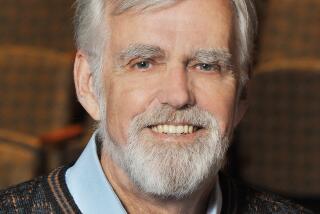TRIO KEEPS FOLK MUSIC ALIVE, WELL
- Share via
The South Coast Trio applies zesty three-part harmonies over crisp acoustic guitar and banjo backing to jaunty songs of free-spirited men a-rovin’ and a-ramblin’, freight trains a-rollin’ and wild horses a-runnin’.
Maybe this isn’t the least commercial sound imaginable in the high-tech music industry of the ‘80s--that honor might better be reserved for something like the ancient religious chants of Tibetan monasteries.
But the members of the Fountain Valley-based group are nonetheless committed to keeping the tradition of U.S. folk music alive in the 1980s. They realize they aren’t about to knock Whitney Houston or Whitesnake out of Billboard’s Top 10 album chart in the foreseeable future.
Still, “I think audiences everywhere respond to story songs, and every song we do is a story,” group leader Jeff Harrison, 42, said this week at his Fountain Valley tennis club, where he was joined by guitarists Roger Shoop, 36, and Pete Wickersham, 42.
“For me,” added bassist and non-singing member Rick Staples, 37, “folk music is family music. Everybody can share it, old and young. It’s very accessible to each group because they all can sing (Woody Guthrie’s) ‘This Land Is Your Land.’ ”
“Yeah,” Harrison joked, “even we can sing that song.”
The group will be busy around Orange County in coming days and weeks, beginning with a concert tonight at Orange Coast College in Costa Mesa, followed by performances at the Irvine Harvest Festival on Saturday and Sunday. On Oct. 17, it will be at Chapman College in Orange for the “Great American Songfest.”
Though there are four members, they stick with the South Coast Trio moniker, Harrison explained, because just three members sing and because they believe the name better connects with such ‘60s folk predecessors as the Kingston Trio.
The group was formed in 1983 when Wickersham, then performing in Costa Mesa, met longtime folk music fan Harrison, who’d placed an ad in the Recycler for “anyone who wants to sing folk music.” Harrison then met Shoop in Las Vegas, and after an impromptu music-making session that lasted until 3 a.m., he called Wickersham and told him: “We’ve found our tenor--you can stop looking.”
Wickersham, who continues to perform solo at a couple of Southland restaurant-nightclubs, is the only member of the group who earns his living as a musician. Harrison and Shoop work for a Los Angeles-based automotive parts distributor. Staples works as a carpenter when he’s not performing with other local musicians, including Orange County singer-songwriter Nick Pyzow.
“I’d rather sing with these guys than do a solo,” Wickersham said, echoing sentiments of the other members - that they would like to see the South Coast Trio eventually become a self-supporting endeavor.
“It’s always a dream,” Harrison said. “It seems in this business you either struggle and struggle and struggle, or you make it really big. . . . It’s hard to get people to call you. Southern California isn’t exactly a commercial hotbed of folk music. I don’t know whether that’s just because people don’t expect to hear it around here.”
Shoop added, “I think that’s part of it, because most people who see us enjoy the music and come back.”
“The main thing that keeps us going,” Wickersham said, “is that we just love to sing.”
There’s more of a market for country music than the type of urban folk the South Coast Trio sings. But Harrison explained why he and his cohorts on’t give their music a greater country slant:
“The advantage we have (as a folk act) is that we’re about the only ones around--besides the big groups everybody knows--who are still doing this. We’re the last of the undiscovered folk groups.”
GORDON LIGHTFOOT AT PACIFIC AMPHITHEATRE: Some musicians are so dependable you could set your watch by them. Canada’s poet laureate troubadour, Gordon Lightfoot, has been delivering the same musically solid, technically impeccable performances for so many years now that a calendar could be measured by him.
Invariably each fall, Lightfoot returns to Southern California, as he did on a slightly damp night Wednesday at the Pacific Amphitheatre, to spend a couple of hours with a few thousand faithful fans digging through his estimable repertory.
It’s true that his recordings by now have become virtually interchangeable in terms of melodic design, lyric themes and meticulous production. But like a veteran home-run hitter, who cracks one out of the park less and less frequently as the years advance, Lightfoot still manages to touch all the bases occasionally with a song like “A Lesson in Love” off his most recent album, 1986’s “East of Midnight.”
In any case, because his song catalog is so deep--he’s written more than 200 songs in the last 20-odd years--his concerts can cover plenty of familiar territory without being excessively repetitive year after year.
Even though he is no longer stretching the limits of contemporary folk music, as he did with such early ‘70s genre masterworks as “Don Quixote,” Lightfoot remains a model of thoughtful, literate music that proves “middle-of-the-road” doesn’t have to be either addled or maudlin.
More to Read
The biggest entertainment stories
Get our big stories about Hollywood, film, television, music, arts, culture and more right in your inbox as soon as they publish.
You may occasionally receive promotional content from the Los Angeles Times.










